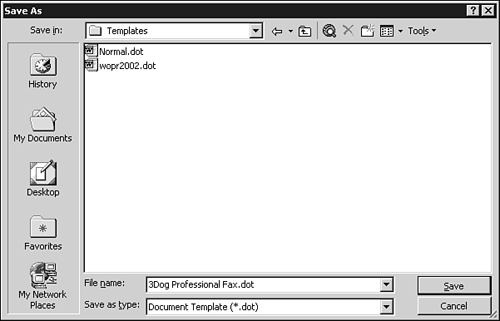Using Word's Built-In Templates
Word ships with scores of templates, and hundreds more are available for download from the Microsoft Web site. Choose Help, Office on the Web to search Microsoft's Web site for additional templates not included on the Office CD-ROM.
Although the generic "click here and type" templates can come in handy in a pinch, you'll want to customize any generic template that you expect to use more than a few times. It's well worth your while to replace the "click here" instructions with text appropriate to your particular situation—your company's name, your phone number, and so on. Here's how to customize Word's Professional fax template, and make it your own:
Choose File, New, click General Templates and on the Letters & Faxes tab, double-click Professional Fax.
Fill out the appropriate portions of the fax template—the information that won't change from fax to fax—such as the company name, address and phone number, and possibly the From: entry.
Choose File, Save, and in the Save as Type box, choose Document Template (see Figure 18.4). Give the template a descriptive name and click the Save button.
Figure 18.4. Customize the built-in templates that ship with Word. It's easy and fast to make them your own.

The next time you want to use the template, choose File, New, click General Templates on the New Document task pane, and select the template name you assigned from the offerings on the General tab.
Many of the built-in Word templates contain interesting examples of techniques discussed elsewhere in this book. The following are the ones you're likely to learn from, starting with the most instructive:
The Manual template (Publications tab) contains dozens of excellent hands-on examples that apply to any document more than a few pages long.
The Résumé templatesMa and wizard (Other Documents tab) use tables, as you might expect. They show you how to set up text on a line so some is left-aligned, some centered, and some is right-aligned. (Hint: Use two tab stops, the one in the middle centered, the one on the right margin right-aligned.)
The Pleading Wizard (Legal Pleadings tab) shows you how to use tables to construct and control horizontal and vertical lines.
The various Report templates (Reports tab) contain several unusual examples of graphic elements in longer documents. These templates are also well worth studying.
The various Fax templates (Letters & Faxes tab) all use tables to good advantage, with different kinds of borders. They also have macros you can use called CheckIt and UncheckIt that allow you to check and uncheck boxes in a document.
The Brochure template (on the Publications tab) contains an interesting example of three-column section formatting, used to create a tri-fold brochure. Work with it long enough and you'll become convinced that Publisher handles simple tri-fold brochures much more easily.
The Directory template (Publications tab) gets you started with a membership roster, or directory of organizations. This template is well worth examining closely for its deft use of styles. Unfortunately, it doesn't include a demonstration of the { styleref} field, which is an indispensable part of most rosters.
If you have to prepare a thesis to complete your MBA, the Thesis template (Publications tab) comes in handy, providing your university conforms to the styles used in the template.
In addition, the Web Page tab includes almost a dozen examples of Web-related formatting that can be helpful if you're constructing Web pages with Word.
If you intend to use any of the built-in Letter templates, be sure to read the indispensable discussion of the Letter Wizard before you go any further. You'll find it in Chapter 16, "Advanced Document Formatting."
